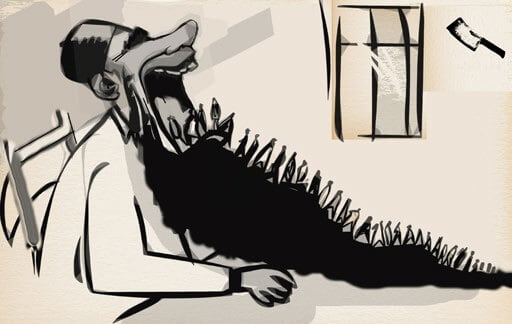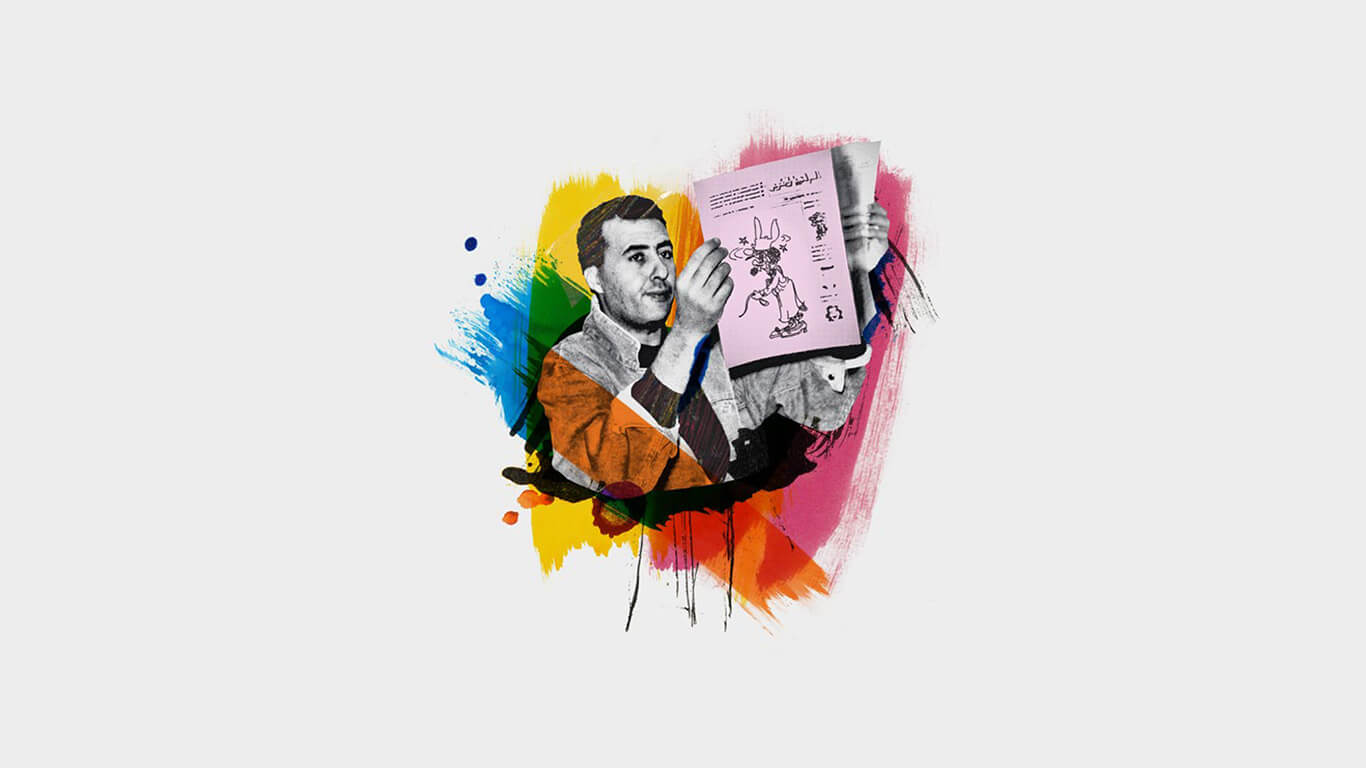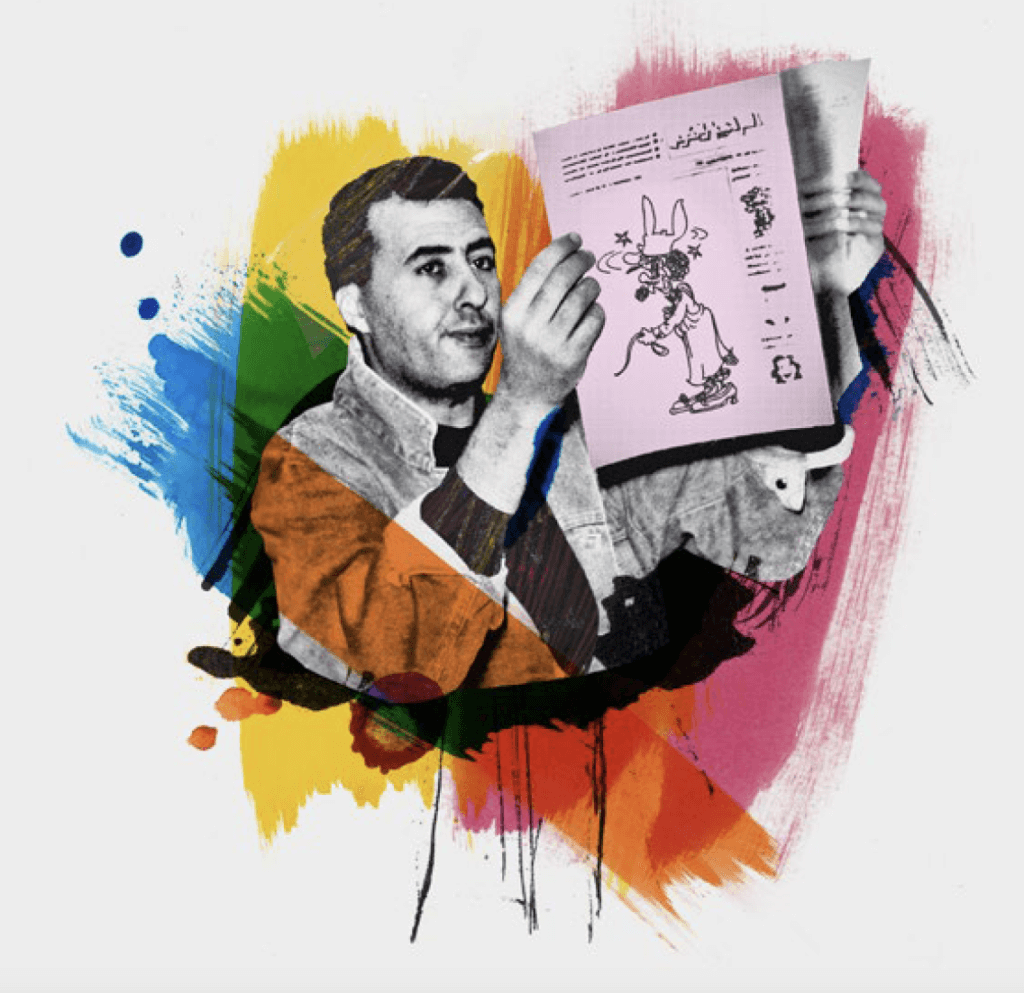RESISTANCE, REBELLION & REVOLUTION
A LIBYAN ARTIST IN EXILE HASAN ‘ALSATOOR’ DHAIMISH (1955-2016)
17th – 30th August 2021
Hoxton 253
253 Hoxton Street, London, N1 5LG
Resistance, Rebellion & Revolution is a project on the life and works of the late Libyan artist and satirist, Hasan ‘Alsatoor’ Dhaimish (1955-2016). Coinciding with the ten-year anniversary of the Libyan revolution, an exhibition at London’s Hoxton 253 offers a ruminative reflection on the artist’s life in exile in the UK, while a new online exhibition of Hasan’s work presents over 5,000 pieces of satire he produced over his long, illustrious career.
As part of the project, in August 2021 a limited-edition book will be published by Pendle Press about the artist – A Libyan Artist in Exile: Hasan ‘Alsatoor’ Dhaimish (1955-2016) by Sherif Dhaimish. Other nationwide events are taking place later in the year in Leeds, Manchester, Pendle and Glasgow. This project has been supported by Pendle Press and Arts Council England.
WHO WAS HASAN DHAIMISH?
Hasan Dhaimish was born in Benghazi, Libya, in 1955. As a child, Hasan would watch his father, Sheikh Mahmoud Dhaimish, draw pigeons on the tiles of their home. The boy was captivated, and soon discovered his own artistic talent. Beside a penchant for drawing and a talent for shooting hoops, music was Hasan’s passion. He would tune into shortwave radio stations to pick up the latest funk and soul from overseas and tape them on his reel-to-reel. Clad in dapper outfits consisting of flares, denim, and tailored shirts, and sporting a giant afro, he certainly looked the part.
At the age of nineteen, Hasan arrived in London, with no intention of staying. Like many who left Libya in the mid-seventies, he believed Gaddafi would soon be deposed and that he would return home to the warmth of Africa. Stepping into cold England wasn’t exactly what Hasan had envisioned – but the country soon became his playground. He’d run wild at reggae festivals, Glastonbury, funk discos, and psychedelic parties like his friends, enjoying life without so much as even a pittance in his pocket. As Thatcherism was on the horizon, he’d taken up quarters in Yorkshire’s Bradford, a city that suffered greatly under the Tories, and then moved on to Burnley, Lancashire.
Hasan had gone from Benghazi to Burnley in an odd change of place that nobody could have predicted. It was a case of life being stranger than fiction, and that also led to him meeting Karen Waddington, whom he married in 1979.
On a trip to London that same year, Hasan spotted an Arabic newsstand outside the Earl’s Court tube station. An orange magazine caught his eye, which was published by the Libyan Opposition. He wrote to them, and soon enough his cartoons were featured. This is when he adopted a moniker and gave to the world.
In spite of economic pressures, and unfettered by life’s harsh realities, Hasan’s creativity continued to flow. When not penning political satire, he’d paint to the sounds of musicians like Miles Davis, Thelonious Monk, and Dexter Gordon, or Blind Wille Johnson and Skip James, bringing jazz and the blues to life through his artwork. He swore by Paul Oliver’s The Story of the Blues, which was to
many of his pieces’ gospel. In the meantime, British satire from Private Eye, Giles, and The Viz contributed to the development of his own unique satirical style: rhythmically witty, acerbically insightful, and playfully relentless.
In the nineties, Hasan trudged through his A-levels and a degree whilst waiting tables at Carlo’s restaurant in neighbouring Colne and fathering three children. In 1995, he began his teaching career at Nelson & Colne College’s graphics department. The rise of the Internet brought a pivotal turn: Alsatoor became global. After the teaching day was over, he’d glue himself to his desk watching Arabic-language news picked up from the array of sketchy satellite dishes he’d accumulated. Hasan began to manipulate screenshots and sound bites, majestically mocking Gaddafi through political satire.

and ISIS were making strong grounds across the country, particularly in Cyrenaica.
Stylistically, his work transformed over the decades in accordance with technology, but his staunch opposition remained unshakable until the very end. Hasan found it hard to maintain hope and fervour for political change in Libya, particularly after the disarmament in 2003, which saw the nation momentarily return to the international community. Perhaps it was the online response that spurred him to carry on, despite the bleak realities. It wasn’t until thirty-six years after leaving Libya, however, that the fight seemed worthwhile at all.
During the 2011 Revolution, he worked interminably as news came thick and fast from all directions. During his final years, Hasan’s artistic flair was subsumed by Libya’s poisonous political landscape. His ambition was always to promote education, creativity, and individuality amongst youth, and he fulfilled this.
First and foremost, he was a teacher; he was a black sheep in all the right ways, and anyone who spent time with him became enlightened somehow, whether in their knowledge of art, music, football, or Libya. Truth be told, Alsatoor became a burden to Hasan. All he wanted to do was paint under the blue skies of the Mediterranean and the grey clouds of Lancashire; but his selflessness and zeal for a free Libya were stronger than his desire to paint.
Hasan’s real creative flare took place in a parallel universe to that of politics. His inspiration was shaped by his musical taste – his days as a kid in Benghazi recording soul on his reel-toreel, to the days of listening to reggae and dub through West Yorkshire’s earth-shattering soundsystems, onto hiphop until he discovered jazz and the Delta blues. Through a series of canvases, prints and an hypnagogic avante-garde video, this exhibition entwines art and exile, and studies how Hasan expressed himself away from the political realm.
Co-curated by his daughter Hanna, this unique and colourfulshow brings Hasan’s work to London for the first time. In the project room, a biographical video will be played on request. The piece has been put together by award-winning video editor, Jake Mobbs, and features a voice over by the artist’s son, Sherif Dhaimish.
©2021 HASAN ‘ALSATOOR’ DHAIMISH






